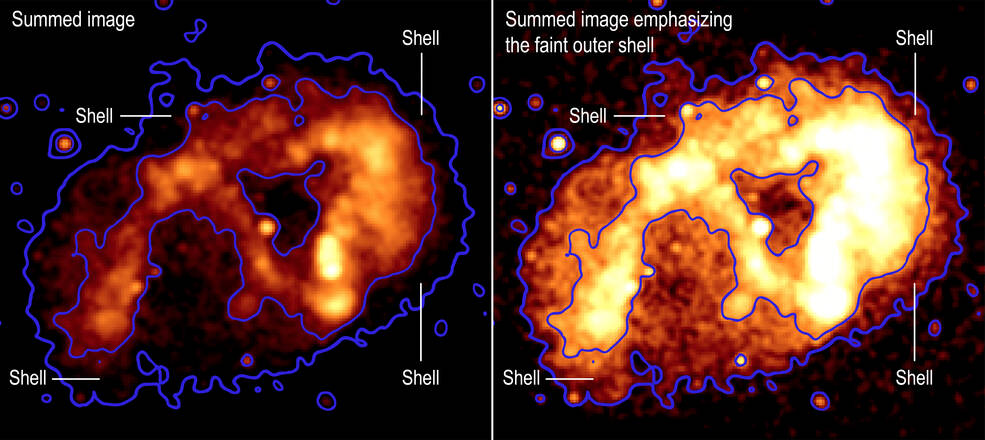A new time-lapse sequence shows Eta Carinae as it changes over time from 1999 to 2020.
Credits: X-ray: NASA/SAO/GSFC/M. Corcoran et al; HST: NASA/ESA/STScI; Image Processing: NASA/CXC/SAO/L. Frattare, J. Major, N. Wolk)
A new movie made from over two decades of data from NASA’s Chandra X-ray Observatory shows a famous star system changing with time, as described in our latest press release. Eta Carinae contains two massive stars (one is about 90 times the mass of the Sun and the other is believed to be about 30 times the Sun’s mass).
In the middle of the 19th century, skywatchers observed as Eta Carinae experienced a huge explosion that was dubbed the “Great Eruption.” During this event, Eta Carinae ejected between 10 and 45 times the mass of the Sun. This material became a dense pair of spherical clouds of gas, now called the Homunculus nebula, on opposite sides of the two stars. The Homunculus is clearly seen in a composite image of the Chandra data with optical light from the Hubble Space Telescope (blue, purple, and white).
A new time-lapse sequence contains frames of Eta Carinae taken with Chandra from 1999, 2003, 2009, 2014, and 2020. Astronomers used the Chandra observations along with data from ESA’s XMM-Newton to watch as the stellar eruption from about 180 years ago continues to expand into space at speeds up to 4.5 million miles per hour. The two massive stars produce the blue, relatively high energy X-ray source in the center of the ring. They are too close to each other to be seen individually.
A bright ring of X-rays (orange) around the Homunculus nebula was discovered about 50 years ago and studied in previous Chandra work. The new movie of Chandra, plus a deep, summed image generated by adding the data together, reveal important hints about Eta Carinae’s volatile history. This includes the rapid expansion of the ring, and a previously-unknown faint shell of X-rays outside it.
This faint X-ray shell is highlighted in an additional graphic showing the summed image. The image on the left emphasizes the bright X-ray ring, and the image on the right shows the same data but emphasizing the faintest X-rays. The shell is located in between the two contour levels, as labeled.
Because the newly discovered outer X-ray shell has a similar shape and orientation to the Homunculus nebula, researchers concluded both structures have a common origin. The idea is that material was blasted away from Eta Carinae well before the 1843 Great Eruption — sometime between 1200 and 1800, based on the motion of clumps of gas previously seen in Hubble Space Telescope data. Later this slower material was lit up in X-rays when the fast blast wave from the Great Eruption tore through space, colliding with and heating the material to millions of degrees to create the bright X-ray ring. The blast wave has now traveled beyond the bright ring.
A paper describing these results appeared in The Astrophysical Journal and is available at https://iopscience.iop.org/article/10.3847/1538-4357/ac8f27
The authors of the paper are Michael Corcoran (NASA’s Goddard Space Flight Center), Kenji Hamaguchi (GSFC), Nathan Smith (University of Arizona), Ian Stevens (University of Birmingham, UK), Anthony Moffat (University of Montreal), Noel Richardson (Embry-Riddle Aeronautical University), Gerd Weigelt (Max Planck Institute for Radio Astronomy), David Espinoza-Galeas (The Catholic University of America), Augusto Damineli (University of Sao Paolo, Brazil), and Christopher Russell (Catholic University).
NASA’s Marshall Space Flight Center manages the Chandra program. The Smithsonian Astrophysical Observatory’s Chandra X-ray Center controls science operations from Cambridge, Massachusetts, and flight operations from Burlington, Massachusetts.
Read more from NASA’s Chandra X-ray Observatory.
For more Chandra images, multimedia and related materials, visit:
Megan Watzke
Chandra X-ray Center
Cambridge, Mass.
617-496-7998
Jonathan Deal
Marshall Space Flight Center
Huntsville, Ala.
256-544-0034


























